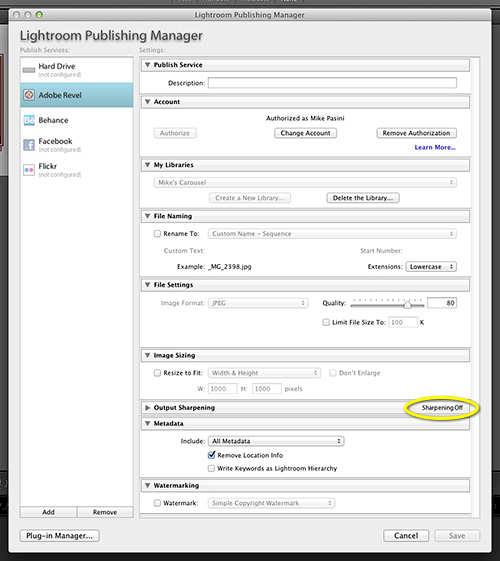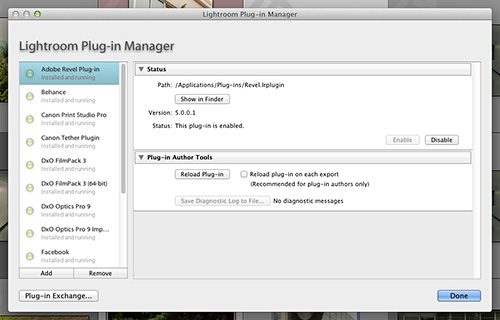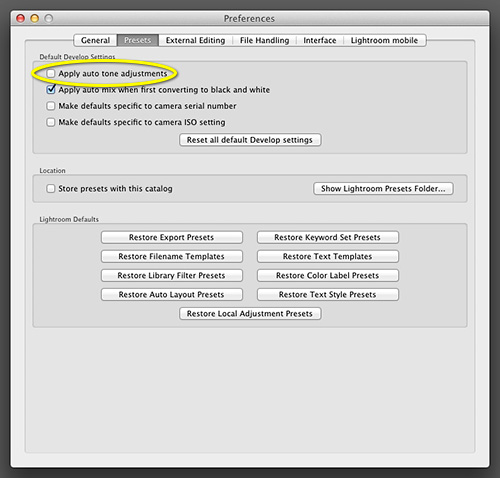Photo Corners headlinesarchivemikepasini.com
![]()
A S C R A P B O O K O F S O L U T I O N S F O R T H E P H O T O G R A P H E R
![]()
Enhancing the enjoyment of taking pictures with news that matters, features that entertain and images that delight. Published frequently.
Solving A Revel Problem With Lightroom




28 August 2014
We noticed it a while ago (in March, actually) but there was no obvious solution. Images we had edited in Lightroom and published to our Revel account using Adobe's Revel plug-in were noticeably brighter in the Revel app than in Lightroom 5.
Even worse, though, when we tried to share the Revel album with a URL, the images displayed in any Web browser were hideous. Black backgrounds were rendered as noisy purple swaths.

Same Image. Our Lightroom JPEG (left) and the Revel rendering at 100 pct.
Was it us?
In Lightroom 5.6, we opened the Plug-in Manager to check the Revel plug-in version (5.0.0.1). That's the latest.
The plug-in is responsible for resizing and sharpening the DNG originals in Lightroom, outputting JPEGs. So we looked at the settings we had enabled in the Revel plug-in by right-clicking on the Revel banner in the Publish Services list.
We had enabled a high level of screen sharpening, which we usually do that for downsized images intended for the Web. But in this case, we were uploading full resolution images. So we turned it off.

Settings. We turned off sharpening.
That wasn't much help. We still had a pretty gruesome rendering of the images in any of our Web browsers. Black backgrounds that were even in Lightroom were still purple, noisy blotches of color with an overall increase in brightness in Revel.
THE PUZZLE
We didn't see anything we could do about this in Lightroom. Everything seemed fine there.
So we tried a couple of things in Revel v1.10 (which is the latest to run on Lion, although we also tried v2.0.0-81 running on Mavericks) to see if we could get a clue or two about what was going on.
The first thing we tried was to export a troublesome image from Revel. We exported the original, not a Revel version of the original (although we didn't make any edits in Revel).
To our surprise the JPEG image we exported looked fine.
So we tried another experiment. We edited the troublesome image in Revel. As it opened, it flashed from the hideous rendering to the correct rendering. It looked great.
We also compared the Exif header data of the Revel export and a JPEG export from Lightroom without finding any clue, although the Revel export did not that Revel had edited the image.
Was it just a rendering issue within Revel?
THE PLUG-IN
We thought we'd search the Web to see if anybody else had the same problem.
Our little adventure yielded two surprises. Nobody else complained about it and Adobe was no longer supporting the Revel plug-in for Lightroom.

Endangered Species. Plug-in Manager didn't complain about the discontinued plug-in.
In fact, we remembered having to reinstall the Revel plug-in for Lightroom 5. Which had seemed odd at the time. Why would Lightroom 5 have deleted an Adobe plug-in? We have a lot of even older plug-ins that are still active.
We were, in fact, fortunate to have a copy of the plug-in to reinstall. Because you can't find it on the Adobe servers any more.
WORKAROUNDS
Two workarounds were suggested by Adobe in the Revel forums.
The first was simply to export your images as JPEGs and then import them all to a Revel album. The problem with that is importing is not publishing, so any subsequent updates you do to the images in Lightroom won't be marked for updating to your Revel album.
The second was to use Lightroom mobile. Synching Smart DNGs of your collection is automatic with Lightroom mobile (you don't even have to Publish). But there are a couple of problems with this workaround.
First, there's no permanent Web URL to share. The Lightroom Web URL disappears as soon as you stop syncing the album.
Second, while a third-party can view either a gallery or a slide show, they can't download the full-resolution originals.
In fact, Revel is Adobe's only solution for anyone who wants to be able to share an album with a group of people who may view it on any device and download the original image. It's the only way to have:
- A permanent URL for the images that can be publicly shared
- An online gallery or slide show at that URL
- The option to download the full resolution image from that URL
And yet, it's no longer supported. And it wasn't working, either.
WHY?
Why would we want all three criteria?
Well, we had a set of graduation images we wanted to not only share but transfer to an interested party. We didn't just want to send the images to them, though. We also wanted a public URL to share the images among all the participants and a way for any of them to download any full-resolution image they liked and might want to print.
And, naturally, we didn't want to push any particular application on any of them. Some of them would be using just phones, others tablets, some laptops, maybe a desktop here or there -- all with various operating systems. We weren't going there.
So a URL to a page that permitted either a gallery/slideshow display or downloads of the full-resolution images seemed the best solution.
And being able to publish to that service from Lightroom has the added benefit of keeping the album updated with our latest edits.
THE OBVIOUS SOLUTION
The solution is pretty obvious. Forget Revel and use another service you can publish to, like Flickr. Flickr offers plenty of free storage space (1-TB), too. So that would have worked, if we were on Flickr.
We could also just use another service, like Dropbox, where you can share a link even with non-members, but we would have to give up publishing.
The trouble with this approach, though, is that some services limit free storage to just 2-GB or traffic (like 20-GB/month).
In fact, because we were out of time, we used Nikon Image Space where we had 20-GB storage sitting around waiting for us. It wasn't pretty but our graduate could show the images on her iPad in a slide show to her grandmother and download any she wanted to print and share the URL with her friends, who could make their own prints for posterity or just grab some new wallpaper.
But then we weren't publishing from Lightroom, so any subsequent Lightroom edits would have to manually be uploaded to the third-party service.
SOLVING THE PUZZLE
The job delivered, we returned to the problem.
It struck us there were two parts to this. Part one was the loss of the plug-in. Part two was the rendering issue.
The first was a political issue and we could not, with all our horses and men, get a policy statement from anyone on the issue of Lightroom support for Revel publishing.
The peculiar implication is that Flickr is a smarter choice than Revel for sharing your Lightroom work. You get a lot more free space and you can publish.
The second was a technical issue. And on that score we were put in touch with Adobe Senior Quality Engineer Harrison Liu, who, it turns out, also uploads Lightroom albums to Revel.
He had seen our screen shots of the problem (like the one above) and tried to duplicate the problem but hadn't been able to. We sent him some files, including a DNG before import and he was able to reproduce the problem.
"Can you tell me how you are converting your Raw files to DNG?" he asked.
We explained our workflow to him.
Briefly, we ingest images from our card to our hard disk using an AppleScript that does the file management while at the same time optionally converts Raw files into DNGs using Adobe's stand-alone DNG Converter. Those DNGs are imported into Lightroom, edited and sent on their way, usually to our Web site.
What could go wrong?
Having reproduced the problem with my DNG, Liu tried converting a Canon Raw file with DNG Converter and importing that into Lightroom. That too exhibited the problem.
"If I took a Raw file," he added, "and used Lightroom to create the DNG, then imported the DNG and published to Revel, I didn't see the same issue from earlier. This may be one potential workaround. While not optimal, you'd still be able to use the Publish feature to keep track of what you have uploaded."
We tried that and confirmed that it worked. Our images in Revel looked like our Lightroom edits.
But was DNG Converter to blame? Not so fast.
We were certainly hoping to salvage our workflow. It's more than just convenient for us. It gives us independence from any third-party approach (which you need when you review software from third-parties) and is completely under our control (which we like more than hoping for updates). If we want to implement something like lossy DNG, we just do. While at the same time populating our archive and working destinations.
So we didn't want to eliminate DNG Converter from our workflow with this workaround.
A day later, though Liu had tracked down the problem.

Lightroom Preferences. Apply auto tone adjustments.
"I played around with Lightroom trying to find a decent workaround for you," he wrote, "and may have found something. Can you check a setting in your prefs, and uncheck it if it is already checked?"
He found that when the Auto Tone preset was applied to the DNG on import, it affected the export to Revel. Disabling that Lightroom preference let the image travel to Revel safely.
Why and how that happens he didn't know. But it was as if the image was wearing a big "Kick Me" sign on its back as it as it made its way to Revel.
AUTO TONE
What is the Auto Tone preset?
It's Lightroom's best guess at what adjustments should be made to your image. It gives you a head start on your own edits more than it optimizes the image. When you open an image in the Develop module, you'll see the Auto Tone preset selected in the left-hand panel.
Oddly enough, when you edit the image in the Develop module, the preset is disabled. And all of our graduation images had been edited, which automatically deselects the Auto Tone preset. So it was not active.
But we had imported all the DNGs with the Auto Tone preference active. And that had been enough to screw things up in Revel.
We aren't going to miss Auto Tone. And even if we did, it would be simple enough to apply it after the import, which does not distort the image, we discovered after some tests.
CONCLUSION
Despite Adobe's reluctance to support the Lightroom-Revel connection, it does still work and remains the only Adobe solution to publishing a publicly and permanently accessible album of full-resolution originals.
There's just two problems. You'll have to dig up the plug-in from some old backup or Internet attic and you'll have to disable Auto Tone on import of DNGs at least.
Otherwise, it's a piece of cake. Graduation cake.